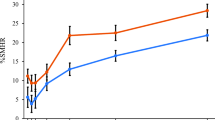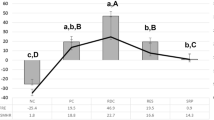Abstract
Objective
The authors investigated the effectiveness of a functionalized tricalcium phosphate (fTCP) combined with a low fluoride level in a mouthrinse to reharden eroded enamel lesions.
Methods
Ninety enamel slabs attached in pairs to removable appliances were randomly assigned to three treatment groups (n = 30/group): (T1) NaF rinse (225 ppm F + 40 ppm fTCP), (T2) NaF rinse (225 ppm F; ACT®), and (T3) no mouthrinse (saliva). While wearing the in situ appliance for 14 days, subjects brushed their teeth with 1100 ppm F toothpaste (Crest©) for 2 min, rinsed with 15 ml of water for 10s, and then rinsed with 15 ml of their assigned treatment mouthrinse. Treatment efficacy was evaluated using surface microhardness (SMH) and transverse microradiography (TMR). Intra- and intergroup comparisons (α = 0.05) were performed using the t-test and ANOVA followed by the Tukey test (HSD).
Results
With SMH, intragroup comparison (t-test) indicated significant rehardening of the eroded lesion with exposure to T1 (p < 0.001) and T2 (p < 0.01) but not with T3 However, with TMR, remineralization was only significant (p = 0.01) with T1, but not with T2 and T3. In the intergroup comparison with percentage change in SMH, T1 was significantly different from T3 (p < 0.01; Tukey HSD) but not from T2, and T2 was significantly different from T3. Intergroup comparison based on percentage mineral gain showed that T2 (p = 0.02) and T3 (p = 0.01) differed significantly from fTCP, but not between each other.
Conclusion
Addition of low level fluoride to functionalized β-tricalcium phosphate promoted rehardening of eroded enamel lesions.
Similar content being viewed by others
References
Amaechi BT, Higham SM (2001) In vitro remineralisation of eroded enamel lesions by saliva. J Dent 29:371–376
Amaechi BT, Hingham SM, Edgar VW (1998) Use of transverse microradiography to quantify mineral loss by erosion in bovine enamel. Caries Res 18:17–24
Amaechi BT, Higham SM, Edgar WM (1999) The use of gamma irradiation for the sterilization of enamel for intra-oral cariogenicity tests. J Oral Rehabil 26:809–813
Amaechi BT, Karthikeyan R, Poornima KM, Najibfard K, Mackey AC, Karlinsey RL (2010) Remineralization of eroded enamel by a NaF rinse containing a novel calcium phosphate agent in an in situ model: a pilot study. Clin Cosmet Investig Dent 2:93–100
Amaechi BT, Ramalingam K, Mensinkai PK, Chedjieu I (2012) In situ remineralization of early caries by a new high-fluoride dentifrice. Gen Dent 60(4):186–192
Attin T, Knöfel S, Buchalla W, Tütüncü R (2001) In situ evaluation of different remineralization periods to decrease brushing abrasion of demineralized enamel. Caries Res 35:216–222
Attin T, Siegel S, Buchalla W, Lennon ÀM, Hannig C, Becker K (2004) Brushing abrasion of softened and remineralised dentin: an in situ study. Caries Res 38:62–66
Cochrane NJ, Cai F, Huq NL, Burrow MF, Reynolds EC (2010) New approaches to enhance remineralisation of tooth enamel. J Dent Res 89:1187–1197
Fejerskov O, Larsen MJ, Richards A, Baelum V (1994) Dental tissue effects of fluoride. Adv Dent Res 8:15–31
Ganss C, Klimek J, Schäffer U, Spall T (2001) Effectiveness of two fluoridation measures on erosion progression in human enamel and dentine in vitro. Caries Res 35:325–330
Ghosh SK, Nandi SK, Kundu B, Datta S, De DK, Roy SK, Basu D (2008) In vivo response of porous hydroxyapatite and beta-tricalcium phosphate prepared by aqueous solution combustion method and comparison with bioglass scaffolds. J Biomed Mater Res 86:217–227
Imfeld T (1996) Dental erosion: definition, classification and links. Eur J Oral Sci 104:207–214
Jaeggi T, Lussi A (1999) Toothbrush abrasion of erosively altered enamel after intraoral exposure to saliva: An in situ study. Caries Res 33:455–461
Jaeggi T, Lussi A (2006) Prevalence, incidence and distribution of erosion. In: Lussi A (ed) Dental Erosion: from diagnosis to therapy. Monography in Oral Science. Karger, Basel, pp 44–65
Karlinsey RL, Pfarrer AM (2012) Fluoride plus functionalized β-TCP: a promising combination for robust remineralization. Adv Dent Res 24:48–52
Karlinsey RL, Yi K, Duhn CW (2006) Nucleation and growth of apatite by a self-assembled polycrystalline bioceramic. Bioinspir Biomim 1:12–19
Karlinsey RL, Mackey AC, Walker ER, Frederick KE (2008) Spectroscopic evaluation of native, milled, and functionalized β-TCP seeding into dental enamel lesions. J Mater Sci 44:5013–5016
Karlinsey RL, Mackey AC, Walker ER, Frederick KE, Fowler CX (2009) In vitro evaluation of eroded enamel treated with fluoride and a prospective tricalcium phosphate agent. J Dent Oral Hyg 1:52–58
Karlinsey RL, Mackey AC, Walke ER, Frederick DE (2010a) Surfactant-modified β-TCP: structure, properties, and in vitro remineralisation of subsurface enamel lesions. J Mater Sci Mater Med 21:2009–2020
Karlinsey RL, Mackey AC, Walker ER, Frederick KE (2010b) Preparation, characterization and in vitro efficacy of an acid-modified β-TCP material for dental hard-tissue remineralisation. Acta Biomater 6:969–978
Lippert F, Parker DM, Jandt KD (2004) In vitro demineralization/remineralisation cycles at human tooth enamel surfaces investigated by AFM and nanoindentation. J Colloid Interface Sci 280:442–448
Lussi A (2006) Erosive tooth wear—a multifactorial condition of growing concern and increasing knowledge. In: Lussi A (ed) Dental erosion. Karger, Basel, pp 1–8
Magalhaes AC, Wiegand A, Rios D, Buzalaf MA, Lussi A (2011) Fluoride in dental erosion. Monogr Oral Sci 22:158–170
Magio B, Guibert RG, Mason SC, Karwal R, Rees GD, Kelly S, Zero DT (2010) Evaluation of mouthrinse and dentifrice regimens in an in situ erosion remineralisation model. J Dent 38:37–44
Mathews MS, Amaechi BT, Ramalingam K, Ccahuana-Vasquez RA, Chedjieu IP, Mackey AC, Karlinsey RL (2012) In situ remineralisation of eroded enamel lesions by NaF rinses. Arch Oral Biol 57(5):525–530
Poggio C, Lombardini M, Colombo M, Bianchi S (2010) Impact of two toothpastes on repairing enamel eroson produced by a soft drink: an AFM in vitro study. J Dent 38:868–874
Reynolds EC, Cai F, Shen P, Walker GD (2003) Retention in plaque and remineralisation of enamel lesions by various forms of calcium in a mouthrinse or sugar-free chewing gum. J Dent Res 82:206–211
Srinivasan N, Kavitha M, Longanathan SC (2010) Comparison on the remineralisation potential of CPP-ACP and CPP-ACP with 900ppm fluoride on eroded human enamel: an in situ study. Arch Oral Biol 55:541–544
Vogel GL, Shim D, Schumacher GE, Carey CM, Chow LC, Takagi S (2006) Salivary fluoride from fluoride dentifrices of rinses after use of a calcium pre-rinse or calcium dentifrice. Caries Res 40:449–454
Voronets J, Jaeggi T, Buergin W, Lussi A (2008) Controlled toothbrush abrasion of softened human enamel. Caries Res 42:286–290
Author information
Authors and Affiliations
Corresponding author
Ethics declarations
Funding
The present study had its own financing. The authors would like to thank the Coordination of Training of Higher Education Graduates (CAPES) for the scholarship (BEX# 6636-10).
Conflict of interest
The authors declare no conflict of interest in this work with a personal or financial relationship that might have introduced any bias or affected our judgment.
Ethical approval
The Local Institutional Ethics Committee granted ethical approval for the study. The study followed the guidelines of Good Clinical Practice and was conducted in full accordance with the ethical standards of the Institutional Research Committee and with the 1964 Helsinki Declaration and its later amendments or comparable ethical standards. All participants signed the informed written consent.
Rights and permissions
About this article
Cite this article
de Oliveira, A.F.B., Mathews, S.M., Ramalingam, K. et al. The effectiveness of an NaF rinse containing fTCP on eroded enamel remineralization. J Public Health 24, 147–152 (2016). https://doi.org/10.1007/s10389-016-0709-8
Received:
Accepted:
Published:
Issue Date:
DOI: https://doi.org/10.1007/s10389-016-0709-8




